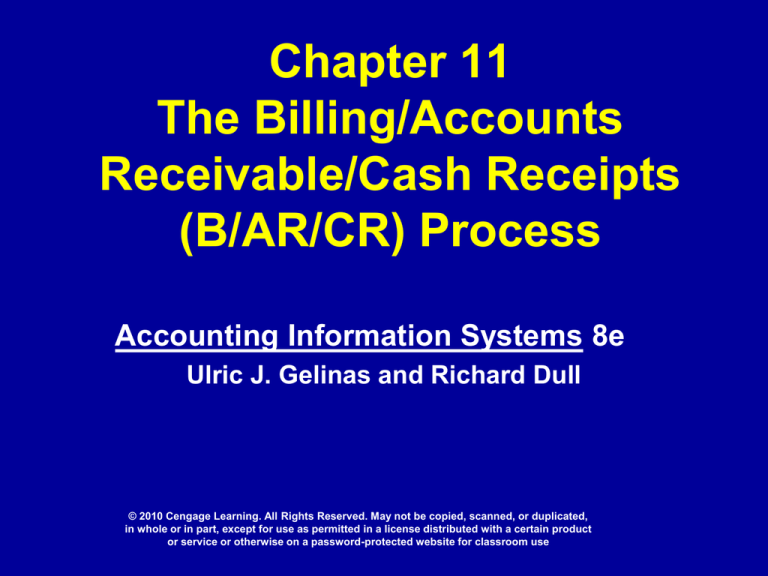
Chapter 11
The Billing/Accounts
Receivable/Cash Receipts
(B/AR/CR) Process
Accounting Information Systems 8e
Ulric J. Gelinas and Richard Dull
© 2010 Cengage Learning. All Rights Reserved. May not be copied, scanned, or duplicated,
in whole or in part, except for use as permitted in a license distributed with a certain product
or service or otherwise on a password-protected website for classroom use
Learning Objectives
• Describe the relationship between the B/AR/CR process
and its business environment.
• Illustrate the potential of the B/AR/CR process to assist
management decision making.
• Summarize how enterprise systems, e-business and
other technologies can improve the effectiveness of the
B/AR/CR process.
• Depict the logical and physical characteristics of the
B/AR/CR process.
• Prepare a control matrix for some typical billing and cash
receipts processes, including an explanation of how
business process control plans can accomplish
operations and information process control goals.
2
Introduction
The billing/accounts receivable/cash receipts (B/AR/CR)
process is an interacting structure of people, equipment,
methods, and controls designed to create information
flows and records that accomplish the following:
– Support the repetitive work routines of the credit
department, the cashier, and the accounts
receivable department.
– Support the problem-solving processes of
financial managers.
– Assist in the preparation of internal and external
reports.
3
Horizontal View B/AR/CR
1. Shipping
department
informs the
accounts
receivable
department
(billing
section) of
shipment.
4
Horizontal View B/AR/CR
2. Accounts
receivable
department
(billing) sends
invoice (2a) to
customer,
accounts
receivable
department
(cash
applications
[2b]), and
general ledger
process (2c).
5
Horizontal View B/AR/CR
3. Customer
makes
payment on
account.
6
Horizontal View B/AR/CR
4. Cashier
sends deposit
to bank (4a)
and informs
accounts
receivable
department
(cash
applications
[4b]) and
general ledger
process (4c) of
payment.
7
Horizontal View B/AR/CR
5. Accounts
receivable
(cash
applications)
informs
general ledger
process of
payment.
8
Cash Receipts Management
• In the billing function, the goal is to get invoices to
customers quickly, hopefully reducing the time it then takes
to obtain customer payments.
• Having the B/AR/CR process produce invoices
automatically helps ensure that invoices are sent to
customers shortly after the goods have been shipped.
• Electronic bill presentment and payment (EBPP) systems
help achieve more timely billing and cash receipts at
reduced costs (Technology Summary 11.1).
• Treasurer’s goal is to reduce float - the time between the
customer tendering payment and the availability of good
funds (funds on deposit and available for use).
9
Cash Receipts Management
• Procedures designed to reduce or eliminate the float associated
with cash receipts:
– Credit card
• For a fee, a third party removes from the risk of non-collection
of the account receivable.
• Collecting company submits charges to the credit card
company for immediate payment.
• The credit card company bills the consumer.
– Debit card
• Authorizes the collector to transfer funds electronically from the
payer’s bank account to the collector’s bank account.
– Electronic banking websites & customer self-service
systems
• Convenient ways for customers to pay bills (electronic banking
website) or obtain information and correct errors (customer
self-service systems).
10
Credit Card Transaction Flow
11
The Fraud Connection
• B/AR/CR process provides opportunity to manipulate
final results.
• Revenues and AR can be inflated by violating GAAP
revenue recognition rules.
• Improper segregation of duties between handling
cash and recording cash transactions can result in
misappropriating cash:
– Lapping occurs when funds being paid by one customer are
stolen and the theft is covered up by applying funds from
another customer and so on.
– Some lapping frauds become so large that the employee has
to manipulate the accounting records after hours.
– Rotation of duties and forced vacations help prevent this
type of fraud.
12
B/AR/CR Context Diagram
13
B/AR/CR
–
Level 0
Diagram
14
B/AR/CR Process - Diagram 1
Perform Billing
15
Sample SAP
Invoice Data Screen
16
B/AR/CR Process Diagram 2:
Manage Customer Accounts
17
Sample Accounts Receivable
Aging Report
18
B/AR/CR Process Diagram 3:
Receive Payment
19
Data Descriptions in B/AR/CR
• A/R master data
– Repository of all unpaid invoices issued by an
organization and awaiting final disposition.
– Two types of accounts receivable systems
exist:
(a) Balance-forward
(b) Open-item
20
Balance-forward System
• AR records show a customer’s balance - current
and past-due and current account activity.
• Monthly statements display previous balance,
payments, and balance forward which is added
to new charges to get the current balance due.
• Unpaid current balances are rolled into the pastdue balances.
• Electric and gas utility companies typically use
balance-only systems.
21
Open-item System
• Appropriate where invoices are prepared and sent
for each sale.
• In the AR master data, each record consists of
individual open invoices, to which payments and
adjustments are applied.
• Periodic statements list invoices (new and settled
within the current period) and payment details.
• Each open invoice is grouped by aging category
and aged individually.
• Monthly, or at specified times, customer accounts
are aged and an aging schedule is printed.
22
Data Descriptions in B/AR/CR
• Sales event data
– one or more invoice records (details contained in
invoice data)
• A/R adjustments data
– write-offs, estimated doubtful accounts, sales
returns, etc.
– journal voucher #, transaction code, authorization
• Cash receipts data
– details of customer payments
23
E-R
Diagram
(Partial)
for
B/AR/CR
24
B/AR/CR Process Relational Tables
25
Types of Billing Systems
• Post-billing system
– Invoices are prepared
after goods are
shipped and shipping
notice compared to
sales order notice.
– There may be a delay
between receiving the
order and shipping.
• Pre-billing system
– Invoice prepared
upon receipt of order
(after inventory and
credit checks).
– There is little or no
delay between
receiving order and
shipping.
26
System
Flowchart
of the
Billing
Function
27
Control
Matrix
for the
Billing
Process
28
System
Flowchart
of the
Cash
Receipts
Process
29
Control
Matrix for
the Cash
Receipts
Function
30







